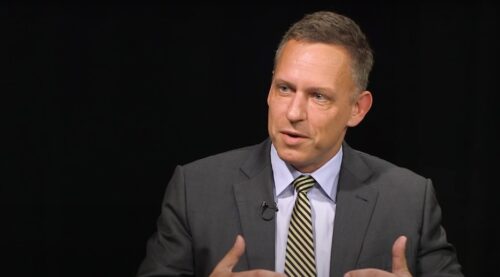William F. Buckley Jr. famously quipped, “I would rather be governed by the first 2,000 people in the Boston telephone directory than by the 2,000 people on the faculty of Harvard University.”
Funny stuff.
But it’s also a serious philosophical statement—solidly American, generally conservative and proudly anti-elitist.
So here’s a translation for technocratic elites who don’t understand: “Ordinary people can be trusted more than lushly credential professionals in ivory towers.” In Buckley’s mind, a healthy democracy requires that average Joes and Janes—random “phone book people”—contribute to the way things are run.
In the philanthropic context, many conservatives would apply Buckley’s bon mot to elite foundations like the Ford Foundation – as well as the academic experts from places like the Harvard faculty on which they have so often relied and whom they’ve cited. According to this thinking, moreover, these experts have essentially been misused by liberal grantmakers like Ford and its allies merely to invoke the highest of academic authority for and justify what they already intended to do anyway. A comparison would be medieval scholastics who invoked Aristotle’s near-sacred status to insist that the sun rotated around the earth!
Recently, however, the Ford Foundation and its allies seem to be questioning their brand of liberal elitism—a discussion that’s both long overdue and well worth having.
A healthy transfer of trust
In October, Ford released a paper, Participatory Grantmaking: Has Its Time Come?, by special consultant Cynthia Gibson, Ph.D. Given Ford’s enduring prominence in the liberal philanthropic establishment, anything it puts out garners immediate attention. Ford’s concept of “participation” as outlined in this paper deserves attention on its own merits—and for what it portends for many others on the liberal side of the grantmaking field.
Gibson defines participatory philanthropy as something that “covers a wide range of institutional and individual activities such as incorporating grantee feedback into grant guidelines and strategy development, inviting non-grantmakers to sit on foundation boards, crowdfunding, and giving circles.”
She then distinguishes the term “participatory grantmaking” to describe a process that narrows the focus to how grant decisions are made and by/for whom. Some see participatory grantmaking as one of many types of participatory philanthropy. Others think it is distinctive because it moves decision making about money—which many see as the epitome of power—to the people most affected by the issues donors are trying to address.
This is a monumental shift from how philanthropy traditionally has allocated funds—a disruption that may explain why participatory grantmaking is still relatively rare, particularly when compared to other forms of participatory philanthropy.
Throughout Gibson’s paper, one sees the anti-elitist impulses from which both participatory philanthropy and grantmaking spring:
“Long-lasting change within foundations will only occur when the field fully embraces participation’s transformative potential and when…people are willing to cede control and power,” she writes, sounding nearly as populist as some of our current elected officials—and that includes folks on both the left and right side of the political spectrum.
“At the heart of the participatory approaches explored in this paper is the notion of trust,” Gibson continues. “For participatory practices to take hold in philanthropy, foundations have to trust the community of non-grantmakers. Foundations also have to value the lived experience and wisdom that non-grantmakers” (think of Buckley’s phone book people) “bring to the table in important decisions about how resources—including money and more—are distributed.”
“We view this [participation] as a question worth a deep dive in the field and offer this paper as a contribution to that end,” says Ford program officer Chris Cardenas in the introduction. “We look forward, along with others considering these issues, to the evolving discussion.”
All in all, Ford should be commended for proposing and starting an important discussion here. Grantmakers on both the left and right should join the Ford-inspired debate.
Ford’s publication represents a healthy and necessary dose of establishment-philanthropy self-flagellation. Foundations should beat up on themselves from time to time—and I mean foundations on both the left and the right.
Everybody in the book
Gibson outlines what she calls a “draft overall framework” to stimulate discussion over the participation she proposes.
She sees four components of this framework. The first two (“Informing” and “Consulting”) do not necessarily have anything to do with grantmaking per se. The third component (“Involving”) can have something to do with grantmaking—or not. The fourth component (“Deciding”) definitely hits the grantmaking bullseye.
Gibson also provides many general and specific examples of activities and processes in each component—it’s important to note that her examples are all from liberal or left-leaning organizations. Of course, these examples are the ones with which she is familiar; still, given her expressed desire for a “common language” and “consensus,” she does appear to exclude right-leaning examples.
Indeed, it’s possible to find many examples of conservative foundations “Informing” and “Consulting” with existing or would-be grantees about program issues and aims, no different from liberal foundations. Both grantmakers and non-grantmakers alike find similar tools in their toolbox: These include public-relations and public-education campaigns; websites; officials’ appearances on conference panels; published papers, articles, and op-eds; site visits; meetings with board and program-staff members, etc.
Also, conservative foundations can be observed “Involving” non-grantees, though perhaps not exactly as outlined in the Ford Foundation paper. Indeed, some conservative foundations are clearly cognizant of being too top-down in their thinking—and know humility is a prerequisite to ultimate success in the exercise of the grantmaking power. Humility is a challenge for any human being or human enterprise. Some conservative foundations attempt to practice it by learning from experts, and listening to everyone—including the real-life, everyday Joes and Janes out in the world.
On the board level, humility represents effective, professional stewardship of resources. On the staff level, it’s just good program officership, part of the obligation owed to board and donor alike.
And yes, there are good boards and staffs among conservative foundations.
Conservative community organizer and civil-rights veteran Robert L. Woodson Sr., president of the Woodson Center, espouses what he calls the “zip-code test.” According to this deceptively simple test, those who really know how to solve a social problem live in the same zip code as the problem. These folks should be actively sought out, consulted, and involved in problem-solving. Not to mention supported in the form of grants from foundations.
Woodson also seeks to include faith-community members in any list of such people. A Bradley Prize recipient, Woodson’s work is supported by conservative foundations that practice what could easily be considered an example of Gibson’s participatory philanthropy, though they wouldn’t recognize the term.
I’m confident Woodson himself and more than a few of his funders actually know people in the “Boston phone book” who should be consulted and involved in philanthropic problem-solving. This goes for folks on both the left and right of the political spectrum. In short, everybody.
By definition, discounting more in decision making
Admittedly, it’s somewhat more difficult to come up with examples of any foundations – liberal or conservative – that allow external participants to be “Deciding” where or how grants should be made, or how they should be evaluated after being made.
Several big risks exist regarding participatory grantmaking. I don’t know whether conservatives are more attuned to it than others, but they might be.
Overall, Gibson’s paper itself properly recognizes potential disadvantages in taking participation all the way to its logical end. “[B]ecause foundations are still fiscally and legally responsible for their operations, they would be remiss in ceding all control over the decisions they make,” she writes in an important caveat.
Another drawback of participatory grantmaking, also acknowledged by Gibson, is the distinct possibility of self-interested behavior by participants. This conflict has risen to the surface more than once. Here’s one example: When a participant represents an actual or would-be grantee.
There are many more instances in which self-interest challenges the integrity of the participatory process. Most often, participants will come from the area being funded; this probably means they are at work in it, or on a board or staff of an involved organization; or have professional or personal relationships with people who are involved. Self-interest often encompasses far more than just financial considerations.
These factors can be easily discounted in the first three of the Gibson framework’s four components. Clearly, self-interest of any sort taints the grant decision-making process, and should be dealt with by the recusal of those involved. (A self-interested foundation board or staff member should work hard to avoid this pitfall. They need to be careful about becoming too close to grantees—which can happen when foundation officials serve on nonprofit boards.)
By definition, any external participation raises the need for vigilance. Human nature’s not going anywhere anytime soon. This realpolitik view of grantmaking ought to make up a larger part of the continuing discussion about participatory philanthropy.
Two broader, more-concerning risks
Gibson’s willingness to challenge the elitist thinking common in current grantmaking practices should be celebrated, but not without caution, since all four components of Gibson’s framework are vulnerable to other serious risks. These risks cannot be underscored enough and warrant much serious, in-depth discussion, as well.
First, Gibson’s participatory philanthropy does not address the important issue of donor intent. Obviously, if the donor is alive and seeks participation, that’s not a problem. But there is a real problem in the case of an absent donor, or one who didn’t approve or even know about participatory grantmaking before departing. External participants very likely will not be as concerned about donor intent as the board and staff of a donor’s philanthropic legacy whose stated role is to safeguard that legacy. Granted, some foundation board members, even those with the best intentions, fail at this all-important philanthropic imperative. But their role as the guardians of donor intent will be made that much more difficult by including individuals from outside the foundation, since those stakeholders will have different intentions and needs.
Finally, there’s a less-charitable, perhaps even cynical assessment of another serious risk. Participatory grantmaking can become a mechanism by which to invoke, then misuse the moral authority of real-life, everyday participants, merely to help lend a foundation the “man-in-the-street” cred. In other words, if this brand of grantmaking acquires enough popularity, foundations will simply give lip service to “participatory grantmaking,” discovering grantees to endorse whatever program they already want to fund.
Ironically, if participatory grantmaking were to be misused in this way—letting the outcome justify the decision—it would perversely resemble the intellectual errors where certain foundations used powerfully credentialed academics or ‘experts’ to justify what they were going to do in the first place. It seems plausible that this could happen.
If so, a Buckley-esque quip about it would be a harsher humorous indictment than the one of Harvard.
Photo by coofdy on Visual Hunt / CC BY-NC-SA







1 thought on “William F. Buckley’s Phone Book vs. the Ford Foundation’s “Participatory Grantmaking””